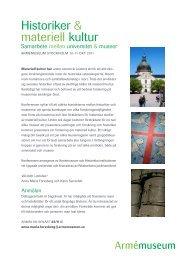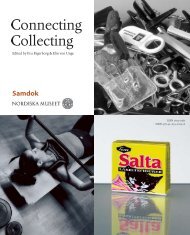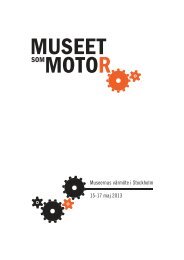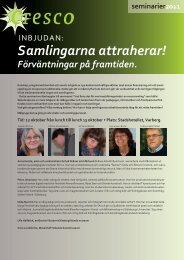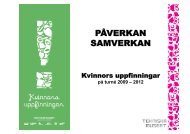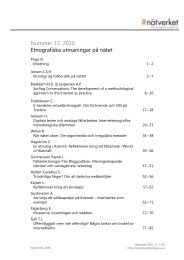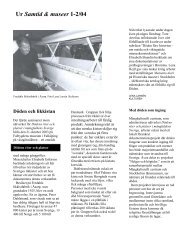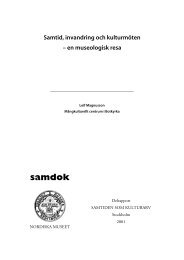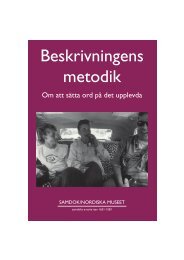Connecting Collecting - Sveriges Museer
Connecting Collecting - Sveriges Museer
Connecting Collecting - Sveriges Museer
You also want an ePaper? Increase the reach of your titles
YUMPU automatically turns print PDFs into web optimized ePapers that Google loves.
<strong>Connecting</strong> <strong>Collecting</strong> X 30 years of SamdokThe Difficult Matters trailer visiting the cityof Norrköping, December 1999. Photo MatsBrunander, Riksutställningar.Difficult mattersIn a parallel project such issues havebeen treated with the focus on artefactswith some kind of problematichistory: Difficult matters: Objects andnarratives that disturb and affect. Thisstarted from the reflection on whetherthe museums’ collecting really gave afull account of post-war Sweden, withboth the light and the dark sides of life.There seemed to be gaps in the artefactbasedcultural heritage. Who dared tolook for problems in seemingly innocentthings? Who saved objects that testifiedto the unmentionable and obscene, towhat was dirty, disgusting or politicallydangerous? Could those who manageour cultural heritage conceive of alsopreserving the memory of tabooed andoffensive things? It was time to examinethe museums’ collecting from an anglethat is not usually covered by activityplans and policy statements.Initially we editors aimed at a book,but underway the project became morecomprehensive. Together with Riksutställningar(The Swedish Travelling Exhibitions)a mobile exhibition, or a fieldstation, was built in a trailer that crossedSweden for almost ten months. In thetrailer there was room for 54 objectsfrom the same number of museums,each with a text about its backgroundand history. The exhibition was on showin 27 places, where visitors were invitedto contribute their own things and stories.In all, narratives from just over 300visitors were documented, from longaccounts with photographs of physicalobjects to short recollections and comments.A useful toolOf course, “difficulty” is not just somethingthat exists; it is contextually conditionedand not always obvious. It israrely a matter of a special history alongsidethe “ordinary”; difficulty is an aspectof all history writing. From this startingpoint, the task of defining what is difficult,what disturbs and affects, was leftto the museums and the visitors. Theircontributions therefore shed light onwhat is both individually and collectivelydifficult, and also the span between whatis obviously difficult and what seemsharmless. Such perspectives give the objectsa justifying ambiguity, that otherwiseseems to disappear in the museums’factual descriptions.The result of this tour was publishedlast year, a selection of 100 objects andnarratives, from museums as well asvisitors. The book’s introduction gives athorough presentation of the project as awhole, including theoretical, methodologicaland ethical considerations from aseries of seminars and other discussions.The project has also interested colleaguesoutside Sweden, and it soon became apart of the current debate on museumsand memories. The concept of “difficult”appeared to be a useful tool to put thequestion of the museums’ contemporaryrelevance on the agenda, for exampleregarding issues such as the recordingof catastrophes and major traumas. Weeditors believe that museums, as publicinstitutions, not only have a moral obligationin these processes, but also an opportunity,through the authority and theserious purpose that is usually associatedwith them.Another part of the current debate isconstituted by the postcolonial issues ofrepresentation and repatriation. Today,no museum can ignore questions suchas: Which people and phenomena arerepresented in collections, exhibitions,and other forms of cultural heritage?How can emotionally fraught issues betackled? How can evil be involved – inparticular the great crimes of history,both yesterday and today? It has becomeimpossible to speak about cultural heritagewithout simultaneously asking thequestion: Which heritage? Whose? Bothprojects, The present day as cultural heritageand Difficult matters, demonstratethe necessity for museum professionalsto continuously reflect upon what theyare doing, and what the consequencesare, for today and for the future. pEva Silvén is curator at the Nordiska Museet,eva.silven@nordiskamuseet.seReferencesSilvén, Eva & Gudmundsson, Magnus, eds.Samtiden som kulturarv: Svenska museerssamtidsdokumentation 1975–2000. Stockholm:Nordiska Museet 2006. / The present day ascultural heritage: Contemporary documentationby Swedish museums 1975–2000. With anextensive introduction and summary in English.Silvén, Eva & Björklund, Anders, eds. Svårasaker: Ting och berättelser som upprör och berör.Stockholm: Nordiska Museet 2006. / Difficultmatters: Objects and narratives that disturband affect. With an extensive introduction inEnglish.The titles can be ordered from the NordiskaMuseet: forlaget@nordiskamuseet.seSamtid & museer no 2/07 • 5



